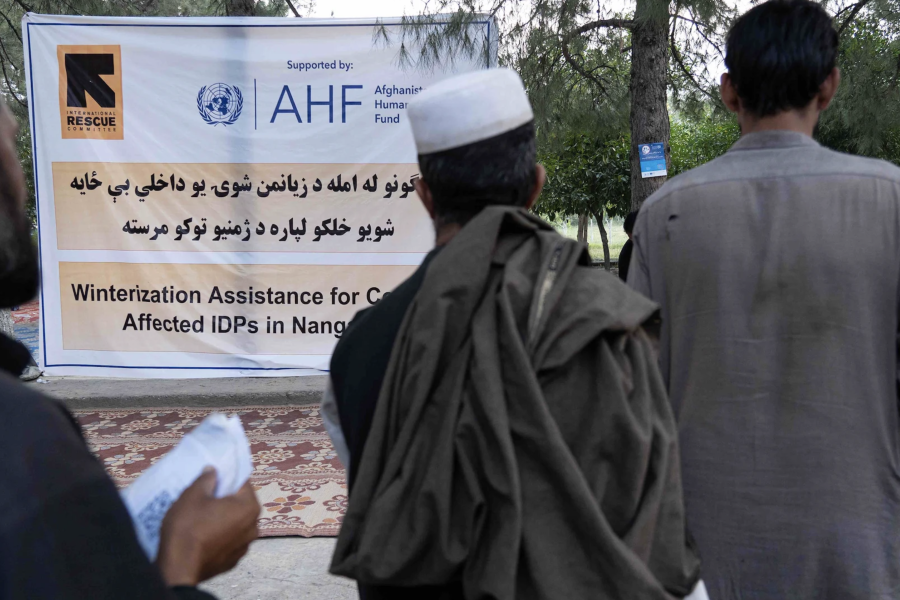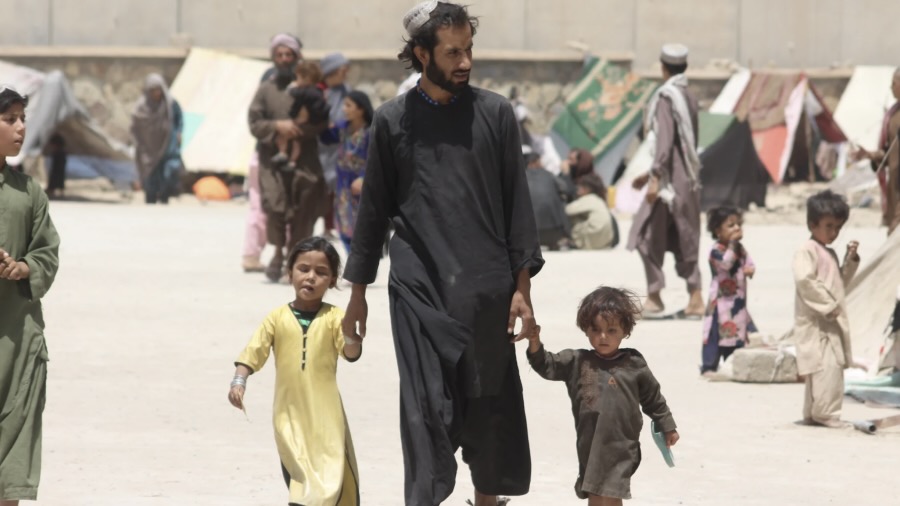August 15 marks one year since the Taliban marched into the city of Kabul, cementing its control over Afghanistan after a blitz of attacks which saw major cities and provinces fall in a matter of days. It signaled the end of a two-decade direct military occupation and war led by the US and its NATO allies, which is estimated to have directly killed 243,000 people, including over 70,000 civilians in Afghanistan and Pakistan.
As the US and its allies hurriedly evacuated their forces and personnel last year, the world witnessed horrifying scenes in Kabul as fleeing refugees clung to departing airplanes. A year later, millions of people in Afghanistan continue to be trapped in what has been described as the “world’s largest humanitarian crisis”.
The World Food Program (WFP) has estimated that 18.9 million people, nearly half of the country’s population, are acutely food insecure (Integrated Phase Classification Phase 3-Emergency and above). The situation in the Ghor province has been especially dire, with 20,000 people reported to be living in Catastrophic (IPC Phase 5) conditions in March through May.
3.9 million children in the country are acutely malnourished, with another 4.7 million at immediate risk. Over 90% of Afghanistan’s population has experienced insufficient food consumption for 10 consecutive months, with 92% of households struggling to meet food needs. Soaring food and fuel prices have compounded hunger, with a 68% hike in the price of wheat and a shocking 107% increase in the price of diesel since July 2021.
Meanwhile, the UN Office for the Coordination of Humanitarian Affairs (OCHA) has stated that 25 million Afghans are living in poverty, with another 900,000 people at risk of losing their jobs in 2022. A mid-year REACH assessment has revealed that total monthly incomes have declined by 15% since 2021. At the same time, the proportion of households in debt has increased from 73% in 2021 to 82% in 2022.
According to a WFP update in July, Afghans are spending almost the entirety of their remaining income on food, with average expenditure on food rising to 90%. Such figures have been accompanied by reports of families being forced to sell organs, and even their children, in order to survive.
The signs of the impending catastrophe in Afghanistan had already become clear within weeks, if not days, after the Taliban seized power.
Amid the chaos of US withdrawal, the United States government announced that it had frozen $9.5 billion in reserves of Afghanistan’s central bank, Da Afghan Bank (DAB), $7 billion of which were held in accounts with the New York Federal Reserve and other financial institutions on US soil.
The European Union followed suit, suspending $1.4 billion in development and emergency assistance for healthcare, agriculture and law enforcement sectors in Afghanistan. The move led to the immediate closure of at least 2,000 health facilities which provided care to around 30 million Afghans.
At the time, Afghanistan was in the throes of six simultaneous epidemics—COVID-19, measles, malaria, dengue, polio, and cholera. In the coming months, hospitals reported major shortages of fuel, medicines, oxygen, and health personnel. By February, only five hospitals in the entire country offered COVID-19 treatment, amid a sharp rise in infections.
Afghanistan’s health system is still struggling to function, and the country has once again been hit by multiple serious outbreaks of diseases including the ongoing COVID-19 pandemic. According to the latest available data from the World Health Organization, over 24,000 cases of Acute Watery Diarrhea (AWD) were recorded between May and August, and over 64,000 cases of measles were recorded between January and August.
There have been 250 confirmed cases and 14 deaths associated with a spread of the Crimean-Congo hemorrhagic fever, which has spread across several regions, between January and August. Outbreaks of dengue fever and cholera have also been recorded.
After years of making Afghanistan’s economy and public systems dependent on foreign aid, the West withdrew aid almost overnight—aid which accounted for 45% of the country’s GDP and 75% of public spending.
Meanwhile, the actions of the US were disastrous and illegal. Seizing nearly the entirety of the DAB’s reserves, which was Afghanistan’s sovereign wealth, pushed the country’s banking system and economy to the verge of collapse. The World Bank, dominated by the US, also revoked the DAB’s credentials, meaning that the bank could no longer interact with the international banking system or financial institutions. The Central Bank was unable to access critical foreign currency reserves.
The value of the Afghani currency against the dollar plunged, inflation rose, there were cash shortages in banks, and millions of teachers, health workers, and other essential workers were unpaid for months. The $7 billion that the US froze in its own territory had accounted for 40% of Afghanistan’s economy and over a year’s supply of essential imports including food and medicines.
The impact of the sanctions and the seizure of funds was severe, with organizations such as the International Rescue Committee warning that the looming humanitarian crisis would kill more people than the 20 years of war.
While the US Treasury Department has issued licenses and guidelines allowing financial institutions to interact with the Afghan government for humanitarian or commercial operations, banks have remained unwilling to process such transactions due to zero-risk policies and overcompliance with sanctions.
In February 2022, the US went one step further, with President Biden issuing an executive order formally seizing the $7 billion and consolidating them into one account. The New York Federal Reserve was then directed to place $3.5 billion in a separate account, with the money to be used “for the benefit of the Afghan people”.
The other $3.5 billion were placed in a frozen account, subject to litigation by victims of the September 11 attacks seeking compensation. Biden’s announcement was met with widespread condemnation, including from families of 9/11 victims.
#Afghanistan: UN experts urge the #US Government to unblock foreign assets of central bank to ease humanitarian impact.
“States have an obligation to guarantee that any activity under their control does not result in human rights violations.”https://t.co/xAEGKJZnF1 pic.twitter.com/9ogcJ4e9lY
— UN Special Procedures (@UN_SPExperts) April 25, 2022
On July 26, Reuters reported that the US and Taliban officials had exchanged proposals for the potential release of the initial $3.5 billion into a trust fund. While the Taliban was not opposed to a trust fund, it rejected a US proposal for third party control over the fund. It has also rejected a proposal to remove top political appointees from the Central Bank, one of whom is under US sanctions.
It is uncertain if and when an agreement will be reached, especially in the aftermath of the US drone strike in Kabul on July 31, which killed al-Qaeda leader Ayman al-Zawahri.
These delays will be detrimental, especially at a time when economic shocks, instead of COVID-19 and conflict, have become the primary driver of the crisis in Afghanistan. The “Mid-Year Whole of Afghanistan Assessment” by REACH found that 60% of households reported experiencing economic shocks in 2022.
The crisis that has been unfurling since August 2021 has also been punctuated by major climate shocks and environmental disasters, leaving millions of people at further risk. Afghanistan is among the countries most vulnerable to climate change in the world. It has experienced recurrent drought, the worst in three decades, as well as recent bouts of heavy rains and flash floods which have caused significant losses of lives, homes, and agricultural lands.

Photo: OCHA/Charlotte Cans
Worsening climate-related events are also a major driver of displacement, compounding the risks faced by an already vulnerable population. According to one estimate, 1.3 million people were internally displaced in Afghanistan in 2021 as a result of conflict and natural disasters. This is in addition to the millions who had already been displaced in the past years.
At the moment, Afghanistan is in the midst of coping with a 5.9 magnitude earthquake which struck parts of the Paktika and Khost provinces on June 22. Over 1,000 people were killed and another 3,000 people were injured. Overall, the UN has estimated that 362,000 people have been affected by the tragedy.
The consequences of the continued illegal seizure of Afghan funds by the US, on top of two decades of imperialist intervention, will be lethal. Joining the UN, human rights organizations, and aid agencies, over 70 economists have written to Biden urging him to unfreeze the money and return to the Afghan people what is rightfully theirs. “The decision to divide these funds in two is arbitrary and unjustified,” they wrote. “And returning anything less than the full amount undermines the recovery of a devastated economy.”
“The Taliban government has done horrific things, including but not limited to its appalling treatment of women and girls, and ethnic minorities. However, it is both morally condemnable and politically and economically reckless to impose collective punishment on an entire people for the actions of a government they did not choose.”





